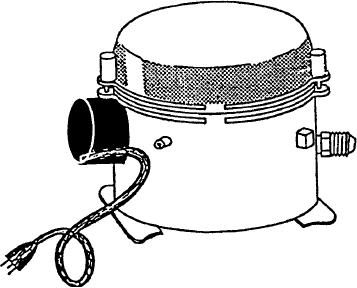
2. Set the operating mode (selector valve) to
opened only when the suction developed by the
PUMP DOWN. (See figure 11-20.)
downward stroke of the piston is greater than the
vacuum already in the line. This vacuum pump can
3. Set the thermostats to the coldest temperature
develop a vacuum close to -30 inches of mercury, which
possible to hold the evaporator coils open.
can be read on the gauge mounted on the unit (fig.
4. Disconnect the ground wire of the hot gas
11-25). You will use the pump when it is necessary to
bypass valve. This de-energizes the valve to prevent
remove air and moisture from the system, a process
bypassing during pump down.
called evacuation.
5. Place a jumper wire on the contacts of the
Evacuating the System
low-pressure relay. Doing so cuts the relay out of the
circuit and keeps the compressor running during the
Evacuation is required to remove all traces of
procedure.
moisture that may have entered the system during
6. Monitor the suction gauge until it reads 5 psi.
maintenance. Moisture turns into vapor under a vacuum
At 5 psi, turn the selection valve to the start-ventilate
and must be removed from the system to prevent
position. This disengages the compressor.
freezing of expansion valves and blocking of
passageways. Moisture also contributes to the
7. Continue to monitor the suction gauge. It will
formation of hydrochloric and hydrofluoric acids in the
normally rise above 5 psi due to the refrigerant still in
system, which can cause corrosion and gumming of
the system. Repeat the pump down procedure until the
internal parts of compressors and piping.
system stabilizes at a maximum of 5 psi, but no lower
than 2 psi.
Whenever the system is opened, precautions must
be taken to prevent loss of refrigerant to the
8. When the system is stabilized at 2 to 5 psi, shut
atmosphere. There are two ways to contain the
down the engine.
refrigerant (gas and liquid). One way is to trap the
9. Close (front seat) the compressor discharge
refrigerant in the receiver (pumping down). The other
valve.
way is to remove it from the system by using a
refrigerant recovery unit, which removes the refrigerant
10. Close (front seat) the receiver inlet valve.
from the mobile air conditioner and stores it in external
11. Close (front seat) the compressor suction
tanks.
valve.
PUMPING DOWN.--The first step in evacuating
12. Remove the jumper wire from the low-pressure
the system is to pump it down by using the following
procedures:
13. Reset the thermostats back to their normal
1. Close (front seat) the receiver outlet valve.
operating positions.
That completes the pumping down part of the
procedure. This part of the procedure could be
performed by using a refrigerant recovery unit to
transfer the refrigerant to an external tank.
EVACUATING.--After the system has been
pumped down and the refrigerant is trapped in the
receiver, you can evacuate the system by using the
following procedures:
1. Connect the refrigerant manifold test set, as
shown in figure 11-26.
2. Ensure that the receiver inlet and outlet valves
are closed (back seated).
ASf11025
3. Ensure that the compressor suction and
discharge valves are closed to the service port (back
seated).
Figure 11-25.--Portable vacuum pump.
11-26

